
Assistive Technology (AT) refers to equipment or devices that help to improve the ability of a person with disabilities to function effectively. AT can include items such as hearing aids, wheelchairs, magnifiers, voice recorders and Braille writing systems. Many people become disabled due to age or illness, but they can often still live independently and even return to school. There are various types of disability, ranging from visual impairment to mental health issues. People who have difficulties accessing information or communicating might benefit from AT. Let’s see the benefits of assistive technology in the article below.
Hearing impairments:
Hearing-impaired individuals can experience difficulty understanding speech. They may therefore need help using some type of assistive listening device. These devices include amplifying machines, headphones and telephones. The first choice would be an amplifier for the user’s normal telephone. If this is not available, then an alternative solution should be selected. An amplified telephone could also be useful for a group of people if one person has their phone. Amplified phones are generally more expensive than other options, however. For those who require amplification at all times, there are two main choices; either a hands-free system or an earpiece. The former works by converting sound into vibrations through bone conduction. This means the individual does not put anything near his ears, so he will not suffer any loss of privacy. Earpieces work by transmitting sound via the ear canal into the internal acoustic meatus. They are less expensive and more unobtrusive when compared with hands-free units. Some models come equipped with features such as volume control and tone control which allow the user to customise the handset to provide better quality.

Vision Impairment
One common problem faced by older users is low vision. The low vision encompasses conditions affecting eyesight that interfere with daily activities. Most people know what blindness is, but many do not realise that low vision affects millions of people over 50 years old. It can lead to problems like headaches, backaches and eye strain – not to mention loneliness. However, it is possible to overcome these challenges. Low-vision aids include specially designed eyeglasses for distance viewing. Other glasses cater for intermediate and close vision needs.

Magnifiers can enhance reading and other tasks, while audiobooks are available if the reader cannot hear well enough with audio-only devices. To make the most out of these aids, one must understand the basic principles of low vision. Firstly, the eye doctor must diagnose the condition accurately. Secondly, you will need to obtain prescription lenses from your optometrist before wearing them. Magnifiers also help people who have short sight to have a clearer vision when playing fr.crazyvegas.com online casino games.
Mental Disabilities
People with intellectual disabilities or learning disorders may face significant barriers in everyday life. Assistive Technologies play a vital role here. Users of wheelchairs can enjoy increased mobility because of wheel brakes, power steering and automatic transmissions. Several other products exist to benefit persons living with physical disabilities such as arthritis. People suffering from cognitive weaknesses can also greatly improve their lives through the use of devices. Some examples include speech recognition software, voice-recognition systems, dictation services and digital notepads. Many of

these tools are being introduced into public sector organizations, as well as private companies and homes.
In conclusion, these are some of the important assistive technologies and their benefits.

